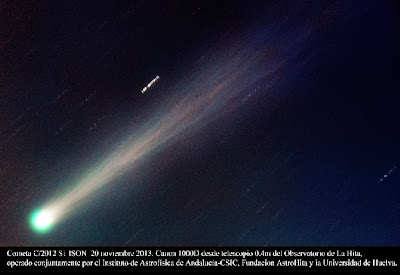MAVEN has successfully launched! It went up beautifully on November 18th as planned and is now on its way to Mars. It should arrive at the Red Planet on September 22, 2014. Watch for more news about the spacecraft then!
 |
| The MAVEN mission patch. Courtesy Wikipedia. |
Speaking of watching things...Comet ISON is starting to get good! The comet now sits at magnitude 4.0, bright enough to be seen by the unaided eye! Unfortunately, it also sits very close to the Sun. So we will still need to wait until it passes by the Sun and swings around for our best view. Hopefully, the comet will survive its close pass by the Sun and emerge as a brilliant object for us to enjoy throughout December. Stay tuned for more information!
Finally, keep your eye on the news for the telescopes in Green Bank, WV. There's a danger that within 5 years, the NSF will eliminate funding for the major instrument there - the Green Bank Telescope. It's primarily used for active astronomical research, but the facility surrounding the GBT allows students like the high schoolers we're bringing there tomorrow to get experience using real-world scientific research equipment. Hopefully, the NSF will change its thinking about this amazing facility only 4 hours from Hampton Roads.
 |
| The GBT at the NRAO facility in Green Bank, WV. Open to visitors, its well worth stopping by if you are going to be in the Wild and Wonderful state next door! |
Oh! I almost forgot! Happy 15th birthday to the International Space Station! Today marks the 15th anniversary of the first launch involved in constructing the now massive station, currently home to the Expedition 38 crew of 6 astronauts. I hope they get to have cake today!
Have a wonderful Thanksgiving, and I'll see you in two weeks!
Carpe noctem,
Kelly


